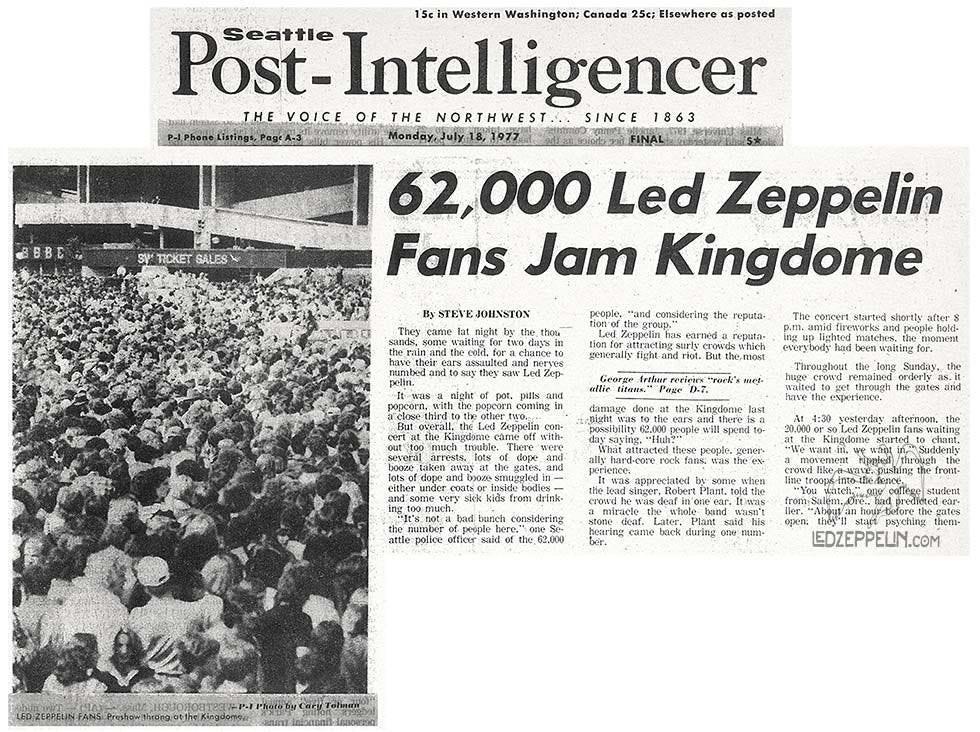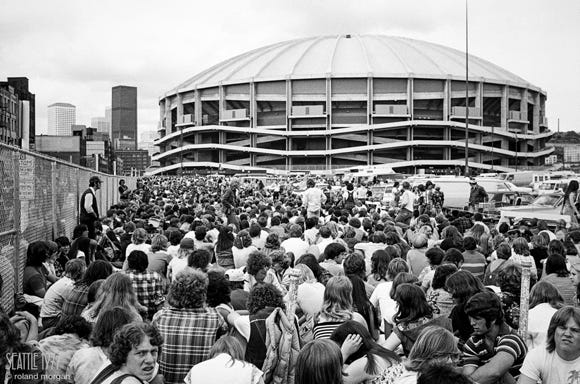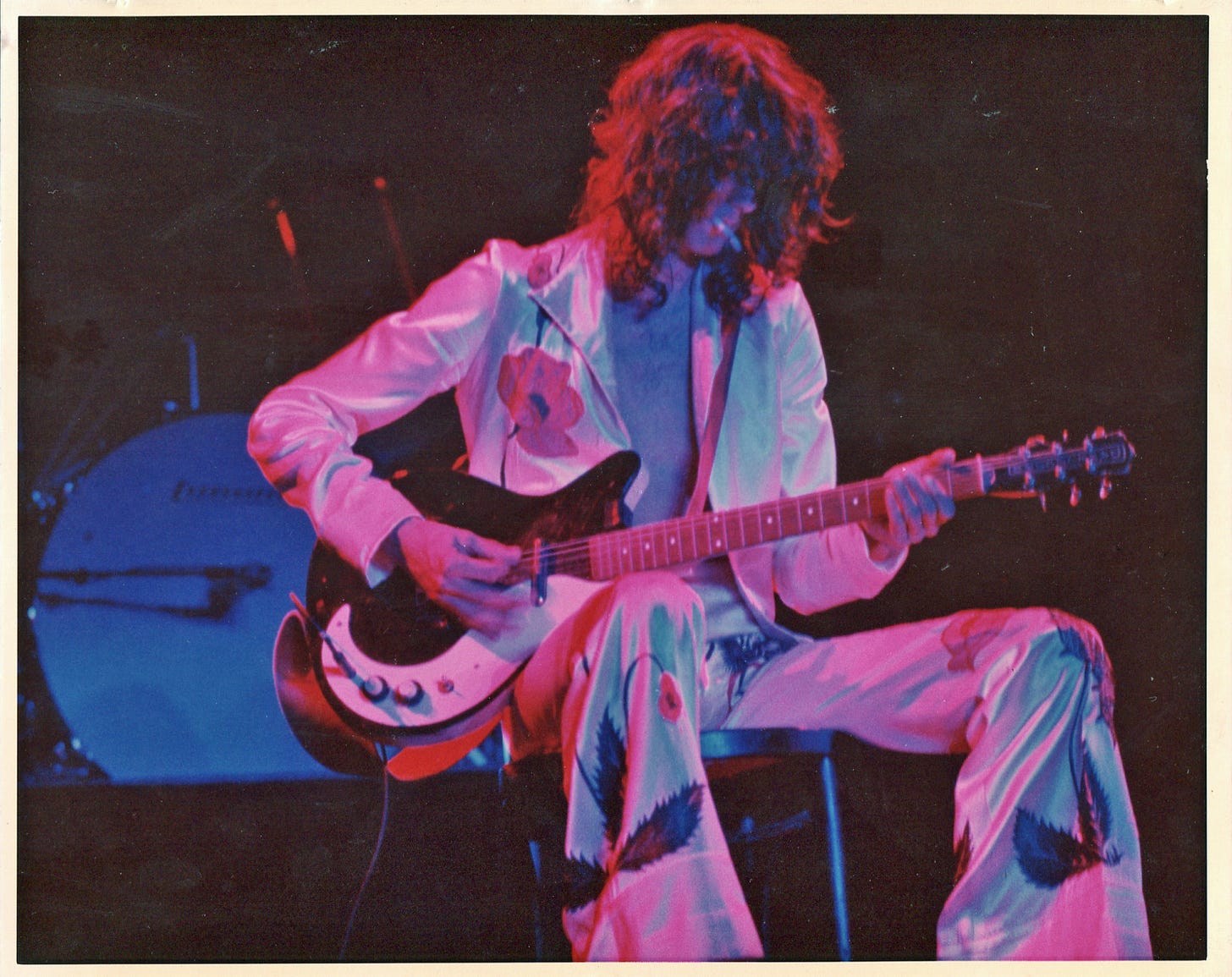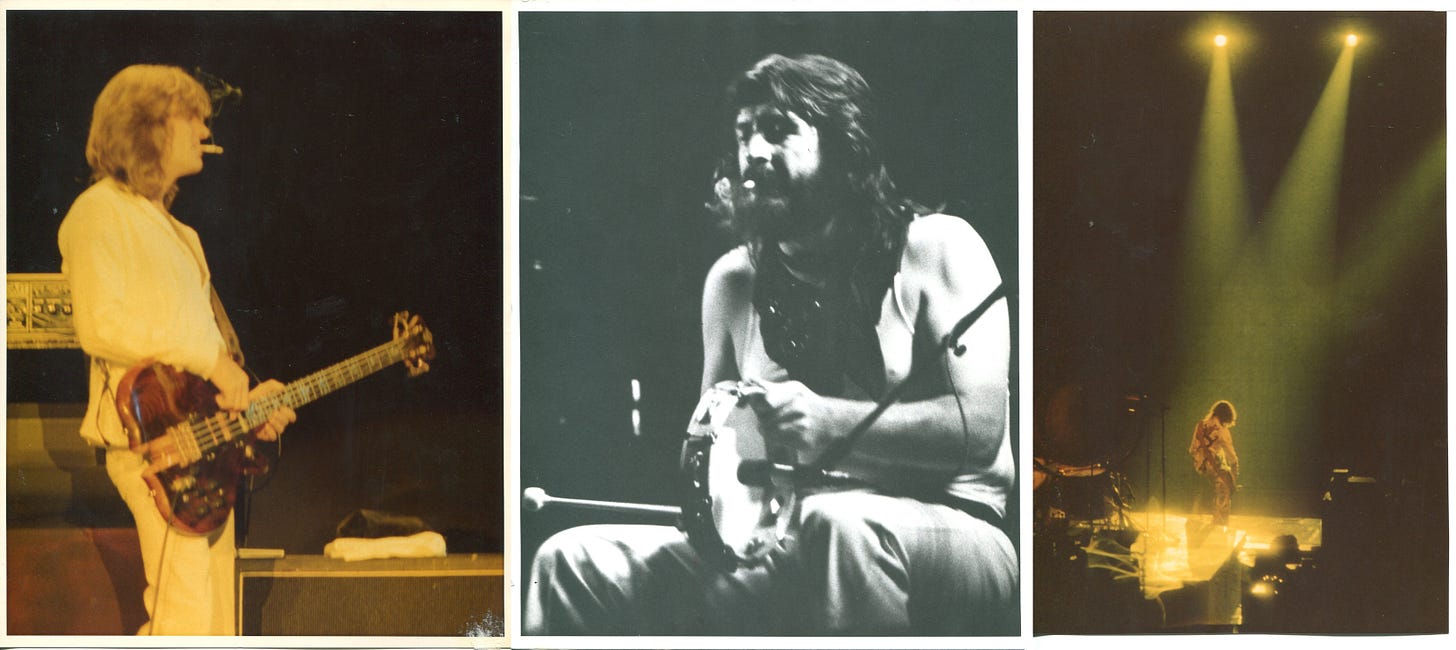The Record Store Years (Side Trip): Led Zeppelin at The Kingdome, July 1977
A memoir of 25 years (1975-2000) spent working in the world of records & music in Seattle, with occasional side trips into writings on Led Zeppelin and other adventures from my musical life.
This show was my ninth and last Led Zeppelin concert, and it occurred at the height of my collecting mania and the peak of the general rock public’s contemporaneous excitement about the band. The Zeppelin window display at Cellophane Square’s U-District store discussed in the previous chapter added to many people’s expectations for the show and my own reputation in the collector community, and it also led indirectly to the first incarnation of my fanzine Proximity.
Years later I wrote this recollection/review of the show for the second incarnation of the ‘zine, issue No. 11 published in October 1993.
By the time of their eleventh U.S. Tour in 1977, Led Zeppelin was universally regarded as the top live rock act in the world; front-page news in every town they played and the most eagerly anticipated show of the summer for every rock fan of the day. Their last tour of the States two years earlier had broken attendance records and firmly established them as the biggest band in the world, but somehow on that tour they had remained in the domain of the true aficionado, if such a thing can be considered plausible when selling out 20,000-seat arenas every night. Media coverage of the 1975 tour was mostly limited to the rock press, and reviews in the daily papers were tucked away in the entertainment section instead of being featured on the front page or as an item on the TV evening news.
Not so in 1977. Not only was there a huge original fan base still young enough to be interested in seeing Led Zeppelin live; now all their younger brothers and sisters wanted to see what the fuss was about, not to mention many more casual music fans and rowdy rockers who would go to any show as long as it was loud and they were wasted. The venues, media coverage, debauchery and concerts themselves were all exponentially bigger than anything attempted before by Led Zeppelin or (arguably) anyone else.
Seattle was a town that Led Zeppelin particularly enjoyed playing in and was the site of at least two of the band's gigs widely acknowledged as among their greatest ever (June '72 and March '75, both at the Seattle Coliseum), thus the anticipation for their 1977 return was especially keen. As the day of the show approached media coverage increased both on the band and its reputation for drawing troublesome crowds, and by the sixteenth of July it seemed like everyone in town was holding their breath as people started showing up in front of the Kingdome with their sleeping bags, lawn chairs and coolers.
Above: The crowd at the Kingdome, July 17th 1977 (photo by Roland Morgan)
The Kingdome itself was a huge, ugly concrete monstrosity; one of those cultural aberrations that inspires dislike but cannot be ignored. Built in the early '70s and demolished in 2000 to make way for a new football stadium, the 65,000-seat covered stadium was still the subject of some controversy in 1977, both for its problematic construction history and its questionable characteristics as a concert venue.
Zeppelin was the fifth rock band to play there; Paul McCartney had christened the place on his 1976 'Wings Over America' tour and Aerosmith, The Eagles and Peter Frampton had all battled the terrible acoustics since, with generally miserable results. None of this bode well for the mighty Zep, as their fabled ability to make a 20,000 seat hall feel intimate was sure to be put to the test by the King County Domed Stadium.
Things got off to a bad start on the day of the show, as the local media screamed about a railroad workman who had been hit by a bottle thrown from the crowd waiting outside the Dome early in the morning of the 17th. By showtime, thousands of people were still in line outside the building, being herded into a few narrow gates and put through a rigorous search for bottles, drugs and fireworks that apparently did little good. Many people didn't even get into the hall until the middle of "Nobody's Fault But Mine," the third song in the set.
Above: Waiting for the show to start; big screen, big PA, big crowd, big stadium.
The band hit the stage at 8:20 p.m. to tremendous crowd response, Jimmy Page in his white dragon suit brandishing the impossibly large double-neck and Robert Plant looking very rock star in blue satin trousers and the usual open shirt. Unfortunately, the sound was terrible from the opening chords and only improved slightly as the evening progressed. Robert called for adjustments to the monitors several times and in addition to audible PA problems the Dome's boomy acoustics wreaked havoc on the sound from just about anywhere in the place - I remember standing right behind the front of house mixing board for a while and wondering how in hell a sound crew could deal with the mush they were hearing.
Above: Onstage at the Kingdome, looking good and sounding rough (photos by Kurt Bloch)
From a technical standpoint, the best part of the show was the huge video screen broadcasting excellent quality images from the stage. This was fairly new technology for big rock shows at the time, and many people spent the whole show watching the screen rather than the little specks on the stage, so far away from most of the seats.
Led Zeppelin as a live band were prone to extremes, especially in the latter days of their reign. Either you got a super-charged, special performance or a lackluster, excessive affair with sub-standard individual showings from one or more members of the band. Rarely did they put on a simply average concert, but this was the case at the Kingdome. Well rested after a three-week break in the tour, Robert's voice was in good form, and Page, Jones and Bonham all played particularly well at various points during the show - Jimmy's solos in "Sick Again" and "No Quarter" were especially sharp and inspired. As a whole, however, the band just never really took off.
The main problem was simply the size of the venue, which muted the audience's response and destroyed the sound; in the battle of "Led Zep vs. The Dome," the Dome ended up winning because it refused to let Led Zep establish the intimate, relaxed atmosphere that usually led to them feeding off the crowd's energy and flying high for three hours or more.
Above: “White Summer/Black Mountain Side” at the Kingdome, July 17, 1977 (Photo by Don Strand).
In Robert's customary greeting to the crowd after "Sick Again," he shouted "good evening!" three times before being satisfied with the response, and even then he seemed dubious, as if he couldn't really hear the crowd from the enormous stage. Later he remarked somewhat wistfully, "Things changed a bit since the little building up the road. Anybody remember the one. . . we used to do a thousand encores, remember?" An obvious reference to the "little" 17,000-seat Seattle Coliseum, site of a four-hour multi-encore extravaganza two years previous, as well as one of their longest and best-ever shows in 1972.
Despite Robert's claim of deafness in one ear and what he euphemistically described as a "touch of sleeping sickness" in Jimmy Page, the band gamely soldiered on, almost hitting their stride a few times but ultimately failing to bring the show anywhere close to true Zeppelin peak level.
The wind really went out of their sails about mid-set due to increasing barrages of fireworks, and by the time Robert introduced the acoustic set he sounded positively unenthusiastic. After "Going To California," he made an effort to stem the tide of pyromania by addressing the crowd. "It's very seldom that we make any comment about, ah, sort of... conduct and things like that, but I think it's about the lousiest thing that you can possibly do to throw firecrackers, right? It would be really about the best thing that you could do on a Sunday night not to throw firecrackers. Everybody agree?" To keep things from getting too heavy he added a good-humored "Eye thank yew" to the plea.
This did seem to slow down the frequency of the explosions, and the second half of the set picked up some steam with brutal versions of "Kashmir" and "Achilles Last Stand." The usual show-closer of "Stairway" was carefully delivered, with a great guitar solo, but as if to underscore their disappointment in the evening they blasted through a single encore consisting of very short versions of "Whole Lotta Love" and "Rock & Roll."
When it was over, 65,000 people shuffled out of the stadium with their ears ringing, and the general reaction around town over the next few days was one of disappointment. It was frustrating to me that my friends who had never seen Zeppelin before got no affirmation of my ravings about their incredible performances of the past, and though no one knew it at the time, this was to be their last visit to Seattle as a band. Three shows later the tour was cut short by the death of Robert Plant's son and America bid goodbye to Led Zeppelin for good.
NEXT: Side Trip: Launching Proximity, Part One
Below: Seattle Post-Intelligencer review of the show from July 18th, and additional photos by Don Strand.














It was April, 1977, I was still 16. The kid who drove the four of us to the Chicago Stadium had just gotten his license. It was a school night, heightening the hysteria of the You’re not going/Watch me chat. LZ is in a column all its own and will always be the answer when someone asks who’s your favorite band.
Great write up of this show, Hugh! When I read that Plant's son died, I had to seek out more about that (https://ultimateclassicrock.com/led-zeppelin-robert-plant-son-dies/). How very sad and ultimately life-changing for him--of course it was, how could it not be?